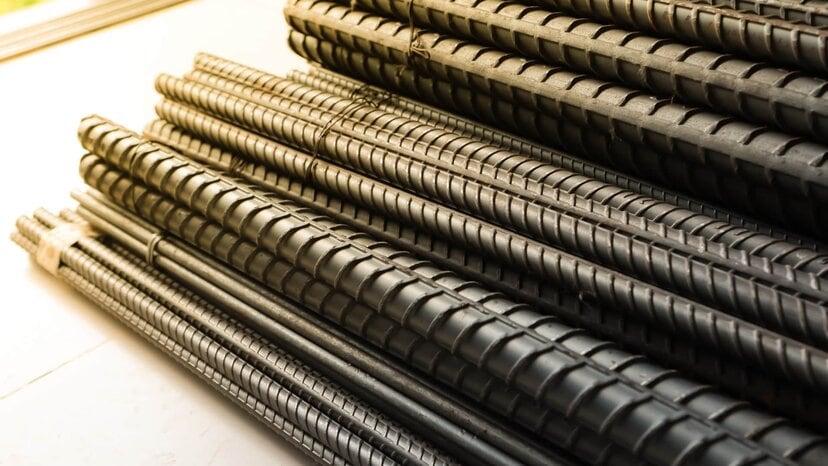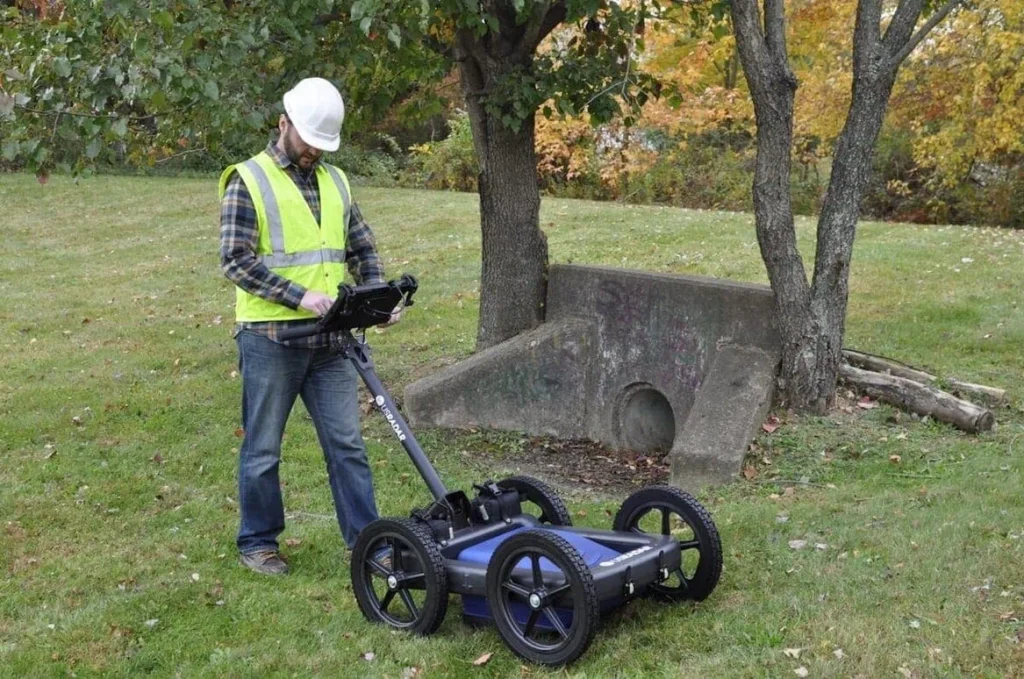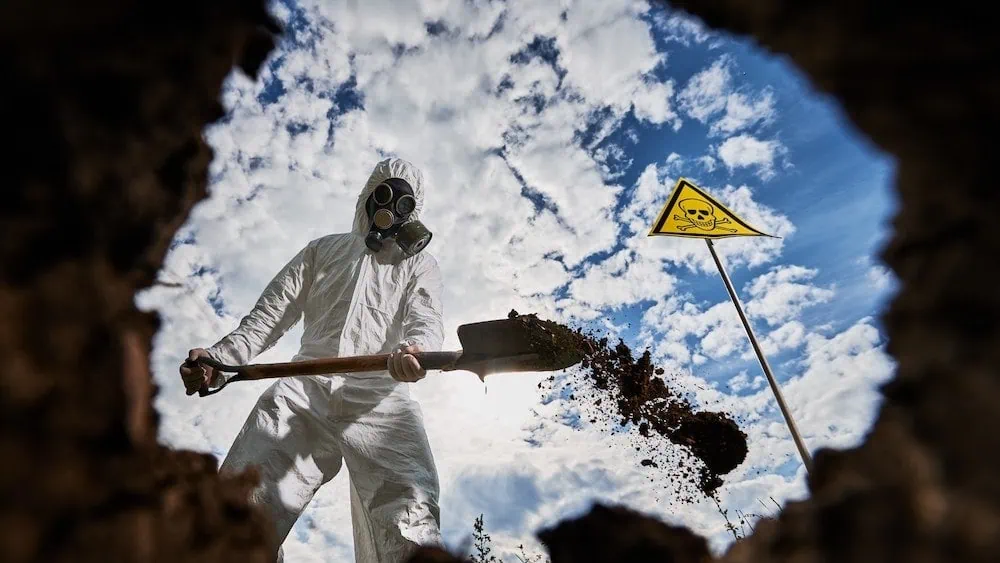Ground penetrating radar is a non-invasive technology used to survey subsurface materials. It’s effective at detecting and measuring the size and depth of a variety of objects buried beneath a range of surfaces. Thanks to its versatility, it’s an excellent choice for professionals in several industries, including:
⦁ Archeology
⦁ Geology
⦁ Construction
⦁ Law enforcement
⦁ Environmentalism
⦁ Oil and gas
A GPR unit works by way of high-frequency radio waves of electromagnetic pulses fired into the ground. When these pulses hit an object, they bounce back to the receiver, which translates the data to the onscreen display. By moving the unit over the surface area, you get continued readings that help the operator understand what objects are below the surface, how deep they are and, in many cases, the object’s dimensions. Put simply, if you need to locate and measure objects underneath soil, sand or concrete without breaking the surface, GPR can help you do it. Continue reading and visit our site and learn more about GPR and its capabilities.
The Many Things GPR Detects
![]()
For non-destructively locating, identifying, mapping and measuring subsurface objects and soil changes, ground-penetrating radar is the gold standard, and that’s been the case for several decades. In terms of depth, accuracy, versatility and usability, there’s simply no contest.
Navy vessels have long relied on sonar thanks to its ability to detect just about everything in the water. When a ping from sonar hits something, it bounces back to provide the necessary information. GPR works on the same principle. If there’s an object in the ground with a different electromagnetic signature than the soil, GPR will find it.
Let’s take a look at the many things GPR can detect.
Structural Components in Cement
Steel reinforcements are difficult to map without the right equipment. Metal detectors will indicate the presence of rebar but don’t provide reliable location information. With GPR, the real-time display shows you exactly where it is and what the measurements are. The data can also be exported if you need to analyze it off-site.
The best part? Because GPR measures changes in subsurface materials, it’s not restricted to finding and mapping rebar. Any non-metal objects or features are detected just as easily. It’ll also help locate voids, identify cracks or damage in the construction and determine slab thickness. For many engineering teams, GPR is invaluable for mapping cement and locating rebar before coring, cutting or drilling.
Pipes and Utilities
![]()
If you’re a surveyor that struggles with your current methods for locating PVC-based piping, you might actually be looking for a GPR unit. Ground-penetrating radar doesn’t falter with non-conductive materials such as the PVC many pipes are made of. It identifies and measures PVC just as easily as metal. The same goes for just about every other kind of piping or plumbing system.
We’ve also known quite a few plumbers who keep a GPR unit as a secret weapon. Why? In addition to accurately locating pipes, GPR indicates when there’s groundwater surrounding them, which makes them extremely handy when locating and diagnosing possible septic tank issues.
Of course, GPR is also superb at locating all manner of utilities. It effectively locates and maps water lines, gas lines, electrical lines and telecommunication lines. The piping and conduit don’t matter — GPR will measure all of them with accuracy, regardless of thickness. The same goes for anything that’s running through the utilities. For surveyors who regularly locate and map any manner of utility, a GPR unit is a mandatory companion.
Voids, Cracks, and Corrosion
![]()
Sometimes, what’s not present is more important than what is. Whether you’re planning a geographical survey or preparing to build a new home, knowing if voids or other disturbances are present is critical. Fortunately, GPR is equally effective at locating and measuring what’s not in the ground. Because radar technology continuously measures the entire subsurface material, when electromagnetic pulses pass through a crack or cavity, the signal changes, helping you locate and measure voids, sinkholes, cracks, corrosion and other disturbances in soil and rock.
If you aren’t interested in dirt, you’ll be glad to know GPR detects the same voids, cavities and disturbances in cement, asphalt and other man-made materials. That makes GPR extremely beneficial for contractors and construction workers who want to avoid costly problems down the line.
Underground Structures
![]()
If you’re in any of the many businesses that require locating and mapping underground structures, there is no method better than GPR. For archeologists studying a centuries-old foundation buried in the ground, GPR provides answers without disturbing the dirt. For geologists searching for cave systems, GPR lights the way. And for mining companies mapping a tunnel system, GPR is a trusted guide.
Unmarked Graves or Tombs
![]()
Time and again, GPR has proven itself unparalleled in helping archeologists locate and evaluate important artifacts that hold valuable insights for academia and society. Unmarked graves and tombs, in particular, can hold a treasure trove of information. Ground-penetrating radar can help locate these sites and improve success rates during excavation. It’s worth noting that GPR won’t distinguish bone from other objects, but it does indicate soil disturbances where bones lie.
The same application is equally useful for law enforcement agencies. When the evidence points to a possible clandestine gravesite, GPR saves valuable time by speeding up the process considerably. Even in situations where a clandestine grave is already located, law enforcement can survey the area with GPR to locate clues that may be crucial to their case.
The Limitations of GPR Technology
![]()
Ground-penetrating radar is incredible technology. That said, it’s important to understand the general limitations when preparing a specific survey.
The biggest limitation of GPR is water content in the soil. Water increases conductivity, which causes GPR’s electromagnetic pulses to disperse much more rapidly than in drier soil. While this actually benefits the system in situations where you’re surveying dry soil for groundwater, GPR depth is compromised in soil with excessive water content. Likewise, GPR doesn’t work well in clay due to its high conductivity.
That said, if it rained for a few hours and stopped and you’re headed out on a survey that afternoon, there’s nothing to worry about. On the other hand, if it’s been pouring nonstop for three days and you’re preparing to head out, you may want to reschedule your survey and let things dry up a bit first.
The other limitation is that, as powerful as GPR is, it does require a time investment to use. The electromagnetic pulses fire into subsurface materials in a cone shape. This means that when the unit first identifies an object, it’s only from one side and from one angle. Collecting enough information to properly identify objects requires multiple scans from multiple angles. And all of these variables depend on the size and shape of the object as well as the detail required.
With these things in mind, GPR is still the best non-destructive subsurface imaging technology available today.
Let US Radar Help You Get Started
No matter your industry, a ground-penetrating radar solution is hands-down the most effective technology you’ll find for imaging underground objects in a non-destructive way. Countless engineers, archeologists, environmentalists and other professionals rely on GPR regularly, and they’d never put their trust in other sub-surface imaging solutions. If you’re ready to join your many peers and start saving valuable time and resources, we can help.
At US Radar, we’ve designed and engineered GPR systems for more than 30 years. During our tenure, we’ve pushed the technology further than even we thought it could go. As a result, we’ve created some of the most innovative solutions on the market today. We also know that new technologies can be intimidating. That’s why we’ve built a global network of representatives to help guide you through the process of finding the solution that fits your needs and making sure you’re confident from setup to deployment to surveying. Get in touch with us today to get started.






